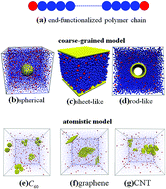Detailed simulation of the role of functionalized polymer chains on the structural, dynamic and mechanical properties of polymer nanocomposites†
Abstract
To systematically study the effect of functionalized chain groups on polymer nanocomposites, we perform our simulation work in the following two ways. In the case of dilute loading of nanoparticles (NPs) with different geometries (spherical, sheet-like, rod-like NPs), we adopt coarse-grained molecular dynamics simulation to study the structural, dynamic and mechanical properties of polymer nanocomposites influenced by the terminal groups of linear polymer chains. We observe that the terminal groups have more probability to be adsorbed onto the surface of NPs with decreasing temperature, chain molecular weight and increasing chain stiffness. For all NPs with different geometries, more terminal groups segregate into the surface of NPs with increase in the interaction energy εf–n between the terminal groups and the NPs. We also notice that the attractive interaction between the terminal groups and the sheet-like NPs induces the appearance of a gradient of translational dynamics of polymer chains, and the relaxation at the chain length scale is evidently different for various adsorbed layers, whereas the segmental relaxation only becomes slightly slower nearby the sheet-like NPs. For both pure and filled systems with spherical NPs, it is found that the stress–strain curves and bond orientations are significantly enhanced with increase in the interaction strength between the terminal groups as well as terminal groups and NPs. In the case of concentrated loading of NPs, we construct the atomistic models of C60, CNT and graphene to accurately account for the “many body effect.” We explore the influence of the functionalization position along the chain backbone on the dispersion kinetics, realizing that the end-functionalization is more effective. The end-groups effect on the chain configuration, chain packing and graphene equilibrium dispersibility is examined. The translational and rotational (segmental and terminal relaxation) dynamics influenced by the interactions between the end groups and graphene are probed by tuning εf–n and the volume fraction of graphene ϕ. Moreover, the shift in the glass transition temperature influenced by εf–n and ϕ is quantitatively estimated by fitting the temperature dependence of the relaxation time using the Vogel–Fulcher–Tammann (VFT) equation. This work is hoped to provide a deep understanding of the polymer nanocomposites with functionalized polymer chains.


 Please wait while we load your content...
Please wait while we load your content...